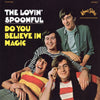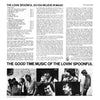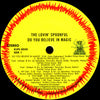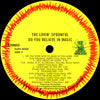







The Lovin' Spoonful – Do You Believe In Magic
Rarity - Sealed
Vocals, Guitar, Autoharp, Harmonica – John Sebastian
Drums – Joe Butler
Electric Bass – Steve Boone
Lead Guitar – Zal Yanovsky
Written by John Sebastian (A1, B1, B4-B6), Mann And Weil (A5), Phil Spector (A5), Fred Neil (B3)
A24, A6, B2 are traditional songs arranged by John Sebastian
1LP, standard sleeve
Original analog Master tape : YES
Heavy Press : 180g
Record color : Black
Speed : 33 RPM
Size : 12'’
Stereo
Studio
Record Press : Pallas
Label : Speakers Corner
Original Label : Kama Sutra
Recorded June–September 1965- Studio Bell Sound, New York City RCA, Hollywood
Engineered by Val Valentin
Produced by Erik Jacobsen
Cover by Joel Tanner
Liner Notes by Antonia, Peter Stampfel
Photography by Charles Stewart
Originally released in October 1965
Reissued in 2011
Tracks :
Side A:
1. Do You Believe In Magic
2. Blues In the Bottle
3. Sportin' Live
4. My Gal
5. You Baby
6. Fishin' Blues
Side B:
1. Did You Ever Have to Make Up Your Mind
2. Wild About My Lovin'
3. Other Side of This Life
4. Younger Girl
5. On the Road Again
6. Night Owl Blues
Reviews:
“By the time of its release, the Lovin' Spoonful's debut album was already a significant record because of the inclusion of its title track, John Sebastian's timeless anthem to love and music, which had been one of the major hits of the summer of 1965. The album elaborated upon Sebastian's gentle, winning songwriting style with the humorous "Did You Ever Have to Make Up Your Mind," which was released as a single in the spring of 1966 and became another Spoonful hit, and the wistful "Younger Girl," which became a chart hit for the Critters. The album also revealed the group's jug band roots in its arrangements of traditional songs like "Fishin' Blues" and "Wild About My Lovin'" and revealed that lead guitarist Zal Yanovsky and drummer Joe Butler, while not quite in Sebastian's league, were good singers as well. The Spoonful would be remembered as a vehicle for Sebastian's songwriting, but Do You Believe in Magic was a well-rounded collection that demonstrated their effectiveness as a group.” AllMusic review by William Ruhlmann.
The Lovin Spoonful had a meteoric career which climaxed shortly after it began in the mid 1960s. Do You Believe in Magic is the 1965 debut album by the group. It displays an incredible diversity of styles, ranging from folk to blues to country, bluegrass, and jug band. Led by composer and vocalist John Sebastian, this debut contains tracks which are equal parts original and innovative along with a healthy amount of reinterpreted standards traversing many American genres.
Sebastian grew up as the son of a studio session harmonica player (of the same name) and he launched his own music career playing the folk circuit in Greenwich Village, New York City in the early 1960s. Along with guitarist Zal Yanovsky and two future members of The Mamas and The Papas, Sebastian formed a group called The Mugwumps in 1964. Later bassist Steve Boone and drummer Joe Butler joined Sebastian and Yanovsky to form The Lovin’ Spoonful. Starting in 1965, the group began recording for Elektra Records before Kama Sutra Records exercised a previous option to sign the Lovin’ Spoonful.
Beyond the 12 tracks which appear on Do You Believe In Magic, the band recorded some of their biggest hit singles in 1965. Sebastian’s “Daydream” is a moderate pop/folk song which reached #2 in both the US and the UK. The rock-oriented chart topper “Summer In the City” was written by Sebastian and Boone and features a signature Hohner electric piano, further expanding the group’s palette.
The album aptly begins with its title song, “Do You Believe In Magic”, an upbeat folk tune with nicely layered guitars and a backing vocal chorus provided by Yanovsky and Butler. Thematically, the “magic” is about the power of music and this certainly resonated in 1965 as this, oft-covered, debut single from the group reached the Top 10 in the US.
As was the custom for debut albums of the time, the bulk of Do You Believe In Magic is cover songs, including the remainder of the original first side. “Blues in the Bottle” features bending, descending notes with Sebastian’s vocals being deep and rustic. “Sportin’ Life” is a slower blues number with some legitimate lead guitars for that genre, while “My Gal” is a fun, rocked up folk song about an alcoholic girlfriend who can “get drunk on shoe polish”. Co-written by Phil Spector, Barry Mann and, Cynthia Weil, “You Baby” is a somber, crooning folk song centering on the vocals, sort of in the realm of Roy Orbison with good mixture of guitar riffs. “Fishin’ Blues” closes out the side by adding a blue grass dimension to the group’s sound, with Sebastian’s vocals matching the country mood and Yanovsky’s consistent pick/slide guitar overtones bring the tune to a new level.
A picked guitar intro gives way to a bright organ rhythm on Sebastian’s “Did You Ever Have to Make Up Your Mind?” with the singer adding vocals with a dynamic range. The second single released from the album, this song reached #2 on the American Billboard charts in 1966. “Wild About My Lovin'” follows as a simple blues track with a moderate rhythm and beat, with the philosophical “Other Side of This Life” featuring a good bass-driven rhythm by Boone.
The album finishes strong with three Sebastian originals, starting with the romantic ballad, “Younger Girl”. “On the Road Again”, is one of the harder rocking songs – in the manor of traditional rock and roll, at least – not too much in way of substance, but a fun song nonetheless. The closing instrumental, “Night Owl Blues”, is the only one credited to all four band members.
It is led by a proficient harmonica through the first section, where Sebastian shows off his talent on this instrument for the first time (he would later do some memorable harp for other artists like The Doors), later followed by a quality lead guitar section by Yanovsky, complemented by some ever intensive playing by the rhythm section.
Do You Believe in Magic reached the Top 10 on the album charts and sparked an avalanche of further hit singles, albums and soundtrack themes over the next two years. Yanovsky departed from the band in mid-1967, followed by Sebastian’s decision to go solo in early 1968, which effectively ended The Lovin’ Spoonful.” Classic Rock Review
Ratings :
Discogs : 3.88/5 ; AllMusic : 4.5 / 5 ; Encyclopedia of Popular Music : 4/ 5 ; MusicHound Rock : 3.5 / 5



